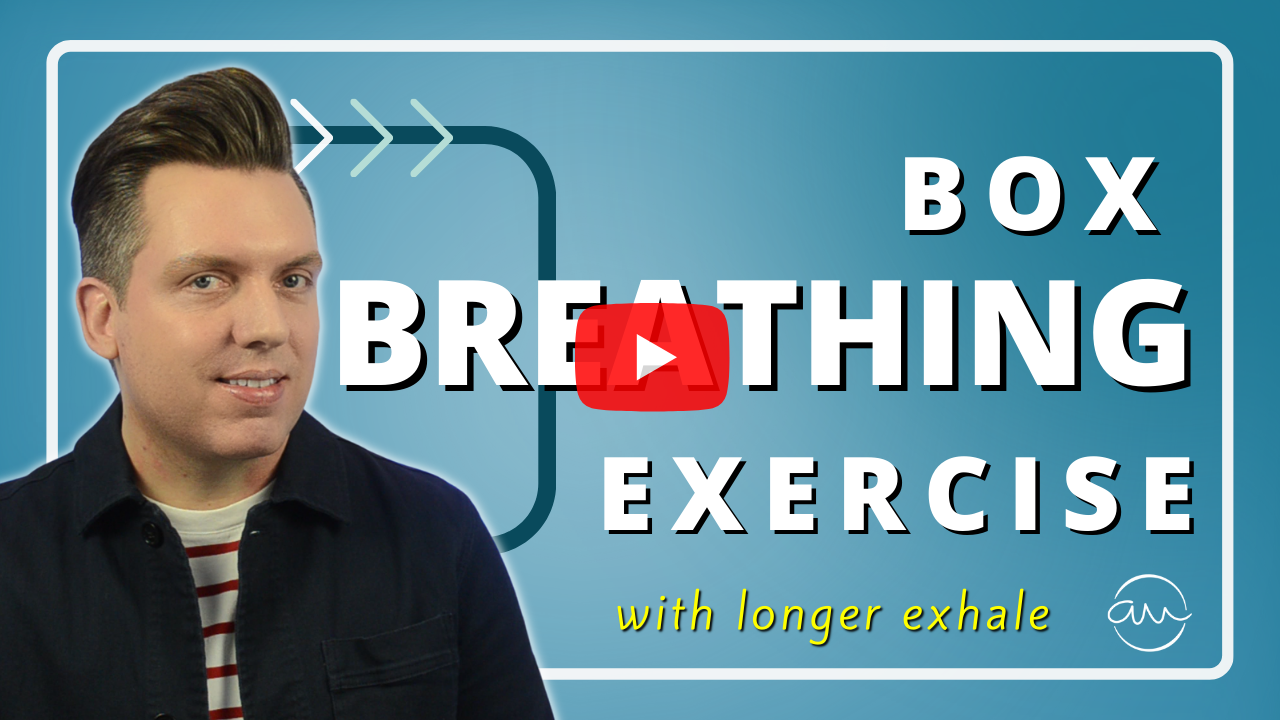There are many times in daily life when all feel anxious, stressed or overwhelmed. And when it happens, practicing breathing exercises is a simple relaxation technique that will help you feel calm, less stressed or anxious. And it can also help with controlling and managing your emotions.
There are many different ways to practice breath work to calm anxiety and stress, and in this article, we'll be exploring a simple and effective technique called Box Breathing and explaining the science behind how it works.
What is Box Breathing?
Box Breathing (also known as square breathing), is a type of conscious breathing technique that can be used to help reduce your fight or flight response. It is also known as "square" or "four-square" breathing and involves inhaling and exhaling for four equal counts, while visualising each count as one side of a square box.
So, box breathing is a useful and effective relaxation technique at times of stress, anxiety, or panic and helps you manage your emotions in difficult situations too. By consciously regulating the breath in this way, you can stimulate the body's natural relaxation response, engaging your parasympathetic response, your rest and digest state which helps you regulate your breathing and bringing as sense of calmness back again soothing your nervous system.
Because box breathing is such a simple technique, it means you can easily do it anywhere, including at your desk at work, on the train or even in the cafe. It's called box breathing because the technique encourages you to think about a box as you do it. And, by focusing on this visual and the pattern of the breaths, it signals the body to relax and can help to lower heart rate and reduce anxiety.
What Are The Steps Of Box Breathing?
Box breathing is a relaxation technique that can help reduce stress and anxiety. All you need to do, is focus on your breath as you inhale, hold it for a few seconds, exhale slowly and then pause for a few more seconds. As you do, it will help your mind and body relax.
Here are the steps to follow:
- Get comfortable, ideally with your back supported with your feet on the floor
- Closing your eyes, focus on your breath as you inhale through your nose whilst counting 1-2-3-4
- Pause and hold your breath whilst counting 1-2-3-4
- Exhale slowly 1-2-3-4
- Low energy levels and fatigue
- Pause and hold your breath whilst counting 1-2-3-4
- Repeat the process at least three times or until you feel a sense of calmness
For best results, I recommend repeating the steps for 5 minutes or as long as needed. You may choose to shorted the count to '3' if it is easier initially, but with practice and repetition, you may choose to extend the count again.
You can also use guided breathing exercises which includes a visual guide which often includes calming music too. My video below includes a simple 5 minute box breathing guided exercise (with a longer exhale which you can follow along with).
Watch this video to practice a guided 5 minute box breathing exercise
Why Does a Longer Exhale Breath Help Calm Anxiety?
When you lengthen your exhale breath, it helps to calm you down because it engages your parasympathetic nervous system. And the parasympathetic response is responsible for calming our body down and allowing us to relax and is sometimes referred to as 'rest and digest'.
When you have a longer exhale breath, you send a signal to your brain that everything is ok and there's no need to be alarmed or panicked. This helps reduce stress levels and activates relaxation responses in your body, resulting in increased feelings of calmness and ease. Also, when you focus on your breath while engaging your parasympathetic response, it allows you to stay connected with your body which means you can become more mindful of you are feeling in any given moment.
So, practicing box breathing with an extended exhale breath can help train your mind to be more aware of your physical sensations and understand when it's time for you take some calming breaths before continuing with daily activities or stressful situations.
The Science Behind Why Box Breathing Works
As we've discussed earlier, box breathing works by activating your body's natural relaxation response. When you breath in deeply and slowly, your heart rate slows down, your blood pressure drops and your body relaxes. This is because when you breathe in through the nose, you activate the parasympathetic nervous system which helps to slow down your heart rate and reduces stress levels. At the same time, exhaling slowly helps to release tension from tight muscles and reduces any physical sensations of anxiety or stress too. As a result, it helps you feel more relaxed and grounded in your body again, regaining a sense of control of your feelings and emotions.
How to Make Box Breathing Part of Your Daily Routine
The most important factor for making box breathing part of your daily routine is to practice it regularly. Try to set aside a few minutes each day for this exercise and focus on your breath as you make yourself comfortable. If possible, try to do the box breathing outdoors in nature or in a quiet space away from distractions. Additionally, experiment with different lengths of time for each phase of the breath cycle so that it becomes easier and more natural over time. With regular practice, you can turn box breathing into a powerful stress-relief tool that will help you stay calm and relaxed throughout the day.
How Often Should you Practice Box Breathing for Anxiety?
For long lasting results and to maximise the calming effects, deep breathing exercises need to be practiced daily. Aim for at least five minutes a day, it can make a huge difference in reducing stress levels and managing feelings of anxiety or panic. Additionally, you can also incorporate box breathing into your daily routine in the form of mini-sessions lasting about two minutes each. This can be particularly helpful during moments of stress or when feeling overwhelmed.
When Is the Best Time to Practice Box Breathing for Anxiety?
The best time of day to practice box breathing is in the morning, just before starting your daily activities. Doing so gives you an opportunity to relax and centre yourself before embarking on the rest of your day. This is especially beneficial if you're feeling anxious or overwhelmed from the start. Additionally, research has shown that making box breathing part of your morning routine can help you maintain a lower stress level throughout the day.
Alternatively, if you find yourself feeling particularly stressed in the evening, box breathing can be used as an effective tool to wind down and relax before bed. This will help promote better quality sleep while also reducing feelings of stress or anxiety that may have built up during the day.
No matter when you choose to practice box breathing, it can be an effective and simple way to manage your stress levels and reduce feelings of anxiety. You'll find that with regular practice, your body and mind will become more relaxed and less prone to triggers.
How Does Anxiety Hypnotherapy Work?
Anxiety can be an incredibly overwhelming and is often characterised by persistent worries and tension, which holds you back in many areas of your daily life, and hypnotherapy helps you resolve the thoughts and reactions that creates anxiety, whilst helping relax your mind and body, breaking the often-debilitating cycle of anxiety and dread naturally.
For clients that experience anxiety disorders, they find combining additional relaxation techniques like box breathing and progressive muscle relaxation with hypnotherapy highly beneficial. It helps boost their results, because relaxation is the foundation of reducing stress and anxiety, we can't be truly relaxed and stressed at the same time. So, the combination of breathing exercises and hypnotherapy can have a powerful impact on reducing the symptoms of anxiety and stress.
In my hypnotherapy practice, I use Solution Focused talking therapy combined with hypnosis. Together we talk and explore your preferred future when you are free of anxiety and consolidate the session with deeply relaxing hypnosis which relives stress and anxiety whilst providing positive suggestions for your subconscious mind empowering you to switch off the anxiety reaction and focus instead on building a positive, confident future.
If you'd like some advice or support in dealing with the impact of stress or anxiety, feel free to get in touch to book a free initial chat. We can explore your situation and decide if hypnotherapy will be right for you and what your personalised plan might look like. Take your first step towards positive change now!








